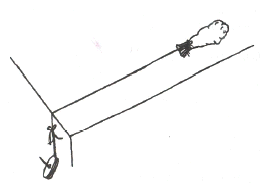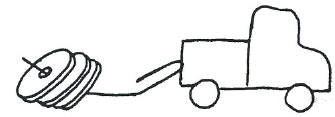TRB 3:3 - Investigation 4 - Collision Zone
Summary
Students will learn how forces of push and pull can change speed or direction.
Materials
Pre-Assessment Activity
- Socks
- One cup of rice
- Piece of string (12")
- Piece of string (36")
- Large paper clip
- 20 Washers
Instructional Procedures Activity
- Worksheet: Collision Zone (pdf) - one per student
- 2 3-Foot dowels per group
- Many small balls - marbles, ping pong balls, super balls, metal balls, cork balls, wooden balls.
Additional Resources
Books:
- Tell Me How Fast It Goes (Whiz Kids) by Shirley Willis (Franklin Watts)
- Feel the Wind by Arthur Dorros (Children's Book)
- The Berenstain Bears Science Fair by Stan and Jan Berenstain (Random House, Inc.)
- Gizmos and Gadgets: Creating Science Contraptions that Work and Knowing Why by Jill Frankel Hauser (Williamson Publishing)
- Forces by Graham Peacock (Steck-Vaughn)
Laser Discs:
- Windows on Science, Primary Vol. 3, Force and Motion Lessons 6-10, 14-17
Background for Teachers
The forces of push and pull cause changes in a speed or direction of objects. When a greater force is applied, the change in speed or direction will be greater also.
Intended Learning Outcomes
1. Use a Science Process and Thinking Skills
2. Manifest Scientific Attitudes and Interests
3. Understand Science Concepts and Principles
4. Communicate Effectively Using Science Language and Reasoning
Instructional Procedures
Attachments
Pre-Assessment/Invitation to Learn
Prepare and perform the following demonstration
- Fill a sock with one cup of rice and tie it shut with the 12" piece of string.
- Attach the 36" piece of string to the cuff of the sock.
- \ Bend apart the two loops of the paper clip (so it looks like an "S).
- Pull out the loose end of the larger loop.
- Attach the smaller loop to the loose end of the 36" piece of string.
Activity:
- Place the bag of rice on a smooth surface (approx. 30" from the edge), with the end of the string with the paper clip, hanging off the edge.
- Predict how many washers will need to be placed on the paper clip before the bag of rice begins to move.
- Predict how may washers will need to be placed on the paper clip before the bag of rice is pulled over the edge of the table.
- Start adding washers to the loose end of the paper clip until the bag of rice begins to move and eventually is pulled over the edge of the table. Compare the results of your prediction with the actual results.

The sock filled with the rice remains the same weight. As force (washers) is added to the paperclip, it reaches the point where the force is enough to move the weight. The greater the amount of force (number of washers), the greater the effect on the weight (sock); thus making the sock move across the tabletop and over the edge more quickly.
Instructional Procedure
Preparation
Tape the dowels together at each end.
Activity
- Place the dowels (ramp) on a flat surface.
- Select the first two balls on the chart and place them on opposite ends of the ramp.
- Predict what will happen when the two balls collide. Write your prediction on the chart.
- Use the same amount of force, roll the balls towards each other. Write what you observe happening on the chart.
- Repeat step 3 and 4 until the students have investigated what happens when each ball has collided with another.

Some balls are all the same size but they are not all the same weight. The weight of each ball helps to determine how it will react when it collides with another ball. The materials used to make each ball will also affect the experiment. Some materials absorb more energy
Extensions
Attachments
Science -
What a Load! (ILO 1)Preparation
- Bend apart the two loops of the paper clip (so it looks like a "S").
- Pull out the loose end of the larger loop.
- Attach the smaller loop to the back end of the moving toy.
Activity:
- Wind-up (or pull the string) on the toy and let it go. Observe the amount of time lasped and distance traveled before the toy stops moving.
- Predict what will happen as washers (weight) are added to the paper clip.
- Place four washers on the paper clip, repeat step four. Compare the results to the first run.
- Place six washers on the paper clip, repeat step four. Compare the results to the first two runs.
- Place eight washers on the paper clip, repeat step four. Compare the results to previous runs.
- Repeat step four, with two additional washers on each new run, until the toy can not move the weight. Compare the results of each run with previous runs.
- Discuss what is happening in this experiment.
The force of the car remains the same. Additional weight is added to each run. At first, the amount of washers (weight) added does not affect the toy's performance. Later on, each additional washer (increased weight) makes it more and more difficult to move the load. Finally, the load (weight/washers) cannot be moved by the amount of force applied.

Homework & Family Connections
Have the students make their own collision zones with the balls they have at home.
Assessment Plan
Did the students complete the Collision Zone chart accurately? Did their predictions become more accurate the further they moved down the chart?
Updated: 05/18/2022


 UTAH EDUCATION NETWORK
UTAH EDUCATION NETWORK

 Justin
Justin Braxton
Braxton Dani
Dani Kayla
Kayla Katie
Katie Matthew
Matthew Rob
Rob Val
Val
